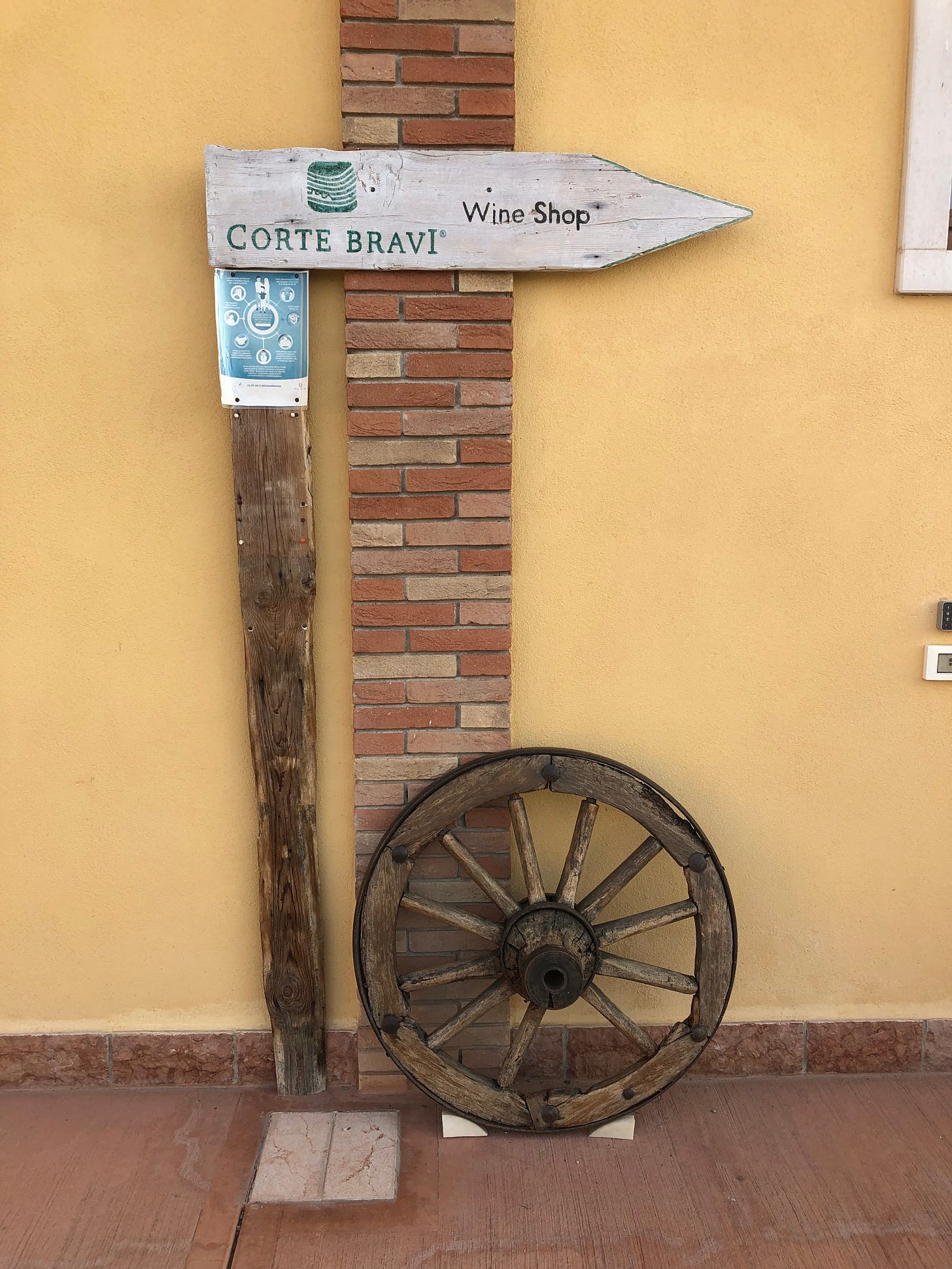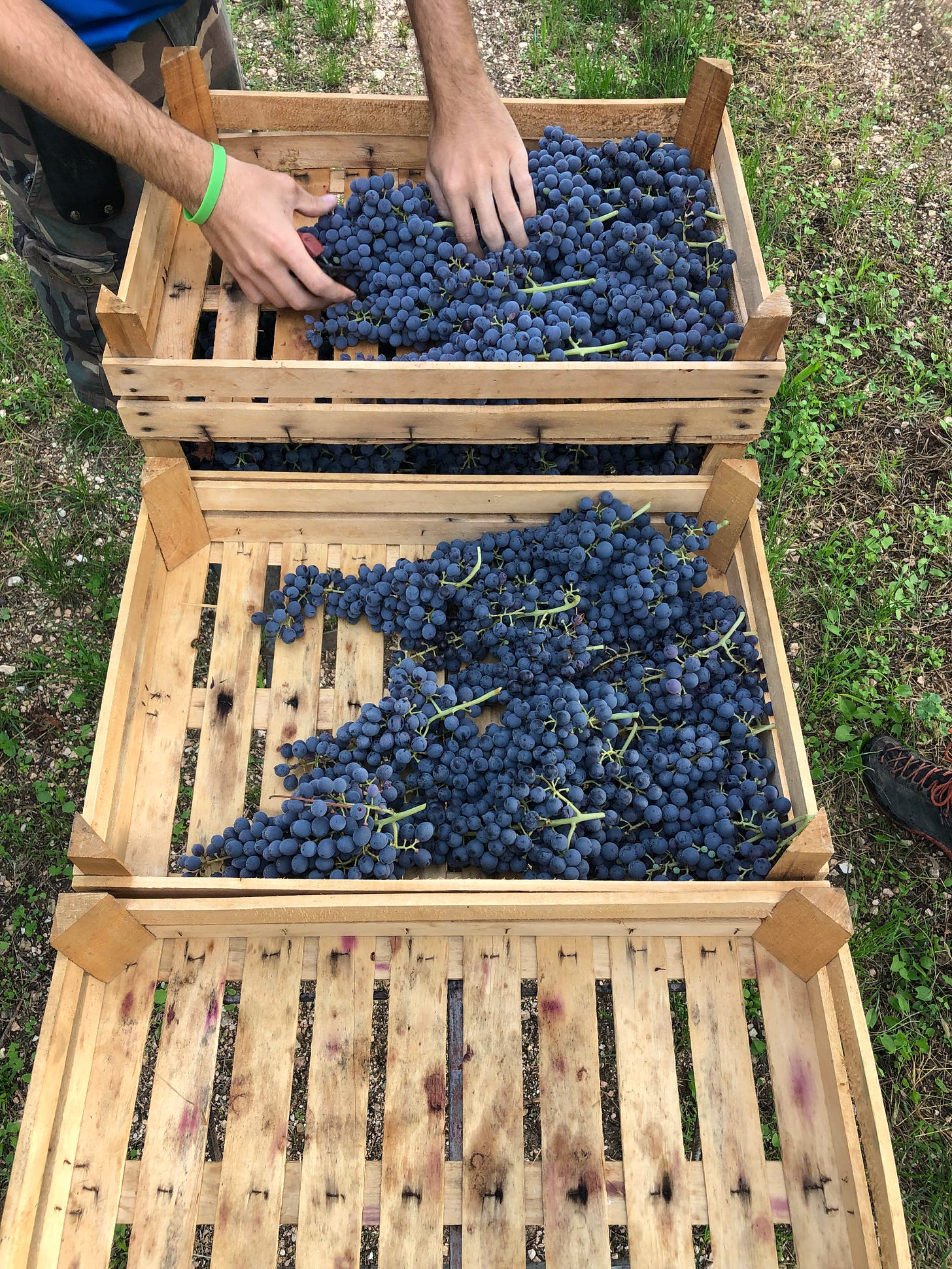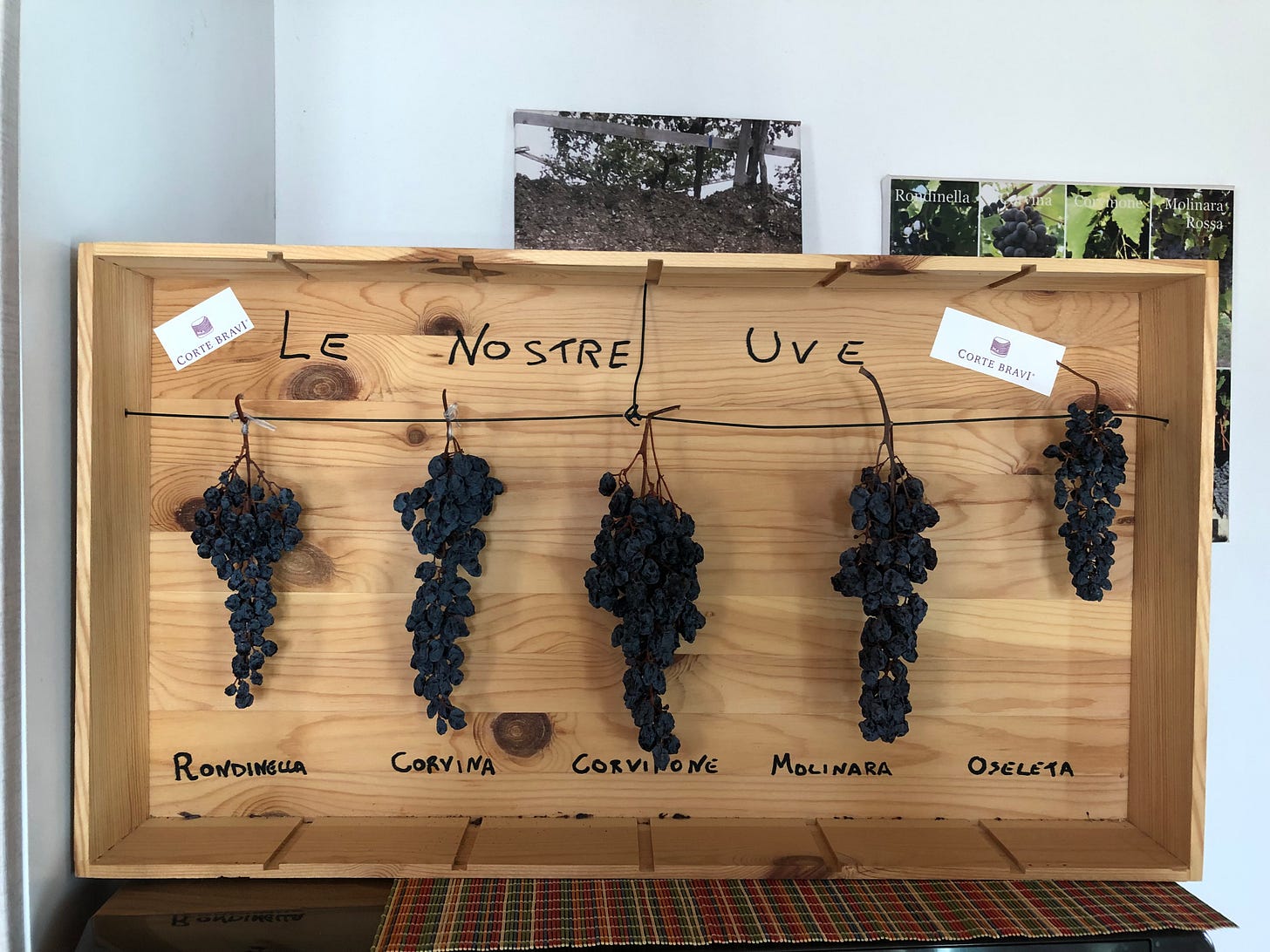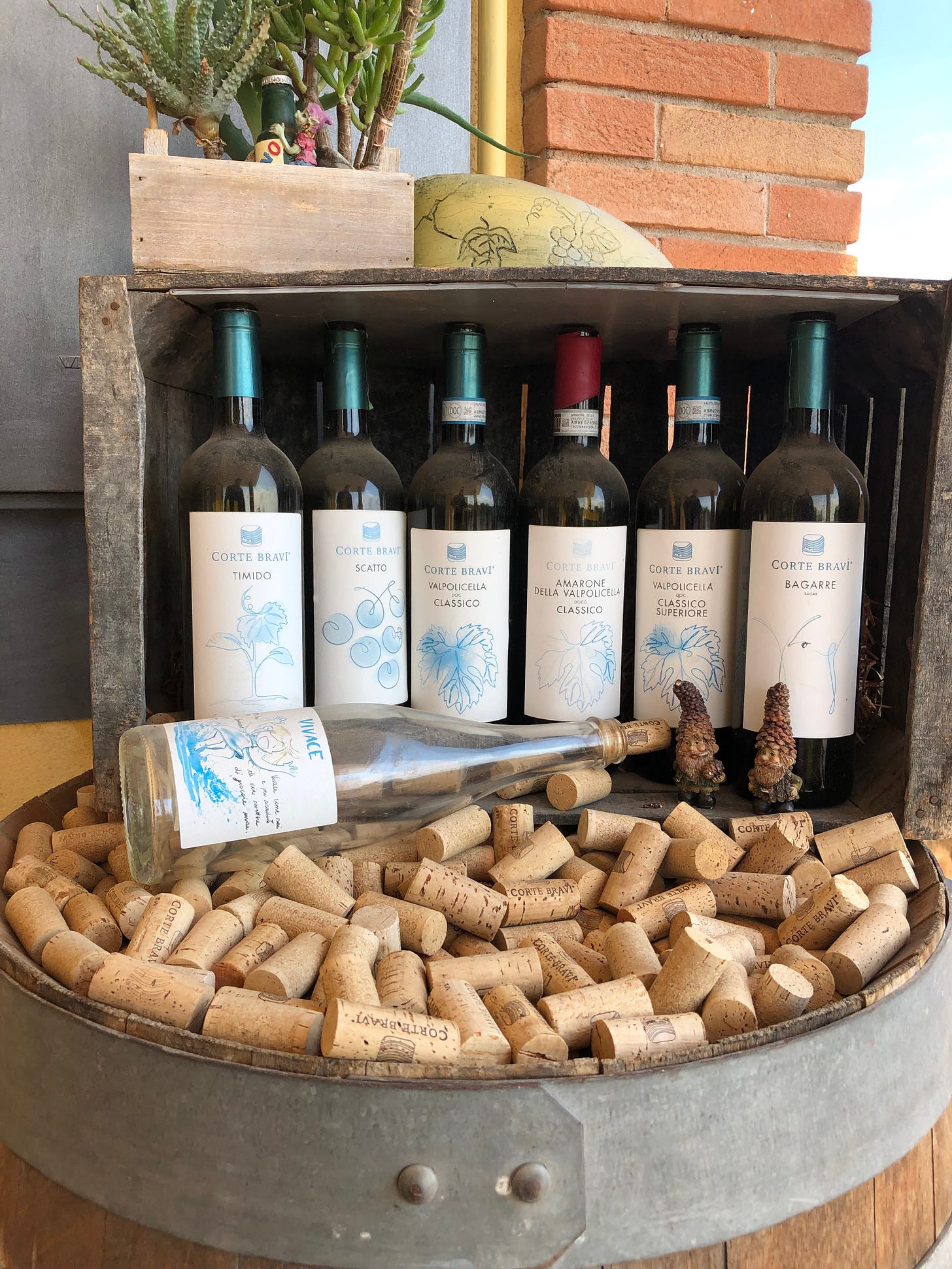Corte Bravi
Organic Amarone & craft beer pubs in Valpolicella
In the heat of harvest in Marche, I felt inspired to keep this feeling going. There were more grapes to be picked and more wine to be made. And I wanted to be a part of it. I reached out to all the winemakers I had exchanged messages with over the last few months, due to the weather and continuous hot temperatures I thought it would be worth a shot to see if some winemakers would need extra help. It was the beginning of August and traditionally a little early for a grape harvest, but as I had seen this season, the effects of a drastically changing climate were causing grapes to ripen earlier and earlier. That may have worked out in my favor.
This producer got back to me right away and welcomed me to come help pick grapes in Valpolicella for their Amarone wine. I wanted to squeeze every opportunity I could out of this summer. It worked out perfectly because at that point, I had not visited the Veneto region. I understood on the surface that Veneto had a deep history with being a wealthier part of the country than the rest of Italy. I was curious to see if that old mindset translated into the wine world somehow. It was also relatively difficult to find a “sustainable wine producer” in this region, or one that would fulfill the requirements I was looking for, for my research. The winemaker was named Andrea was very cordial and accommodating, even excited to have me! He spoke little English, but at this point, it did not phase me, as I was leaning into the experience of only speaking Italian.
Corte Bravi was run by Andrea, his brother and his father. The vineyard is quite literally in the “backyard” of his parents’ house. His own house and the cellar also on the property. I stayed at his neighbor's home, as the family had recently renovated the floors of their home into a bed and breakfast including four different rooms1. It almost felt unfair to be staying in such lovely accommodation. For most of the summer I was lugging a backpack on a hot, smelly train, or staying in a spare bedroom with a twin bed fit for 10-year-old. It was a treat, but it felt undeserving. The room itself was larger than my new apartment, and for the first time in over a year, I slept with the AC on. It was one of the best nights of sleep I had all year.
My train arrived in Verona with enough time to visit the local craft beer bar and grab a slice of pizza for dinner. It was Sunday and I had a feeling that nothing would be open or within walking distance of their house. If I wanted dinner, I had to prepare it, now. Luckly, I found a take-away pizza place and ordered something to eat and something for takeaway. Turns out I was right, and I ended up eating that cold verdure pizza for dinner.
Verona, while beautiful, seemed strange to me, like a movie set, not displaying real Italy, or at least the one I had come to know. After living in Rome, I became accustomed to the trash, the wildness, the unkept nature of the city, it felt uneasy to be in a place where there was so much organization. There was even a bike lane that started at the train station, something unheard of Rome. I liked the city, but I didn’t love it. I have been told and learned since then that it is in fact a college town. But also a major tourist destination, being the home of Romeo and Juliet.
The first day began early, at 7am. Not only was I one of the first guests at this B&B, I was the only one. I felt bad when the entire family woke up and presented me with the entire breakfast buffet spread. Croissants, with my pick of jam, fruit and coffee, of course. The youngest daughter was excited to meet me and practice her English, so we chatted over breakfast. Her mother asked me if I liked any particular pastry, because they wanted to grab a box of pastries from their favorite pasticceria for the next morning. Of course, I can never say no to a cornetto filled with pistachio. It was the beginning of August and traditionally a little early for a grape harvest, but as I had seen this season, the effects of a drastically changing climate were causing grapes to ripen earlier and earlier. The plan was to pick grapes for Amarone. In order to make Amarone wine, grapes are picked, laid out on wooden crates and then left to dry, technically raisinate in the stable, cold temperatures of the cellar. This process is called apassiamento.
As we walked through the vineyards, snipping bunches of grapes, carefully and with attention to ripeness, Andrea and one of the workers were chatting about the fact that there are not many wineries in the region of Valpolicella that grow grapes organically. Like areas like Barolo and Barbarsco, the monetary value of the region is too big to fail, so many winemakers use whatever methods necessary. Andrea puts in a lot of work to ensure that his vineyards are not only farmed organically, but that the land supports biodiversity. He went into a lot of detail about the fact that his wines are made without using artificial yeast strains but by using naturally occurring yeasts present on the grapes. So, in order to ensure that his grapes have healthy yeasts living on their skins, he treats the land as naturally as possible.
The work was so different in Valpolicella than in Marche. I spent the same number of hours picking grapes, but because the vines were trained by Pergola Veronese instead of the Guyot system the grapes hung above our heads rather than close to the ground. While I was picking, I realized how much easier it was to pick grapes by reaching up rather than bending down, knee deep in weeds and vulnerable to the beating sun. The sun was out for the entire day, but I never felt the heat like I did in Marche. The Pergola provided shade and kept me cool. Contrary to my experience in Marche, we had designated breaks for coffee at 9am, lunch promptly at 12:30pm, and another coffee and merenda at 4pm AND THEN aperitivo when the work ended, around 6:30pm. Andrea’s mother was the force behind keeping everyone well fed. I had not spent extended time with an older generation Italian mother (as an au pair the mothers I worked with were no more than 10 years older than me) and I was not sure if her actions were typical of Italian mothers. At lunch she could not sit still, she constantly got up from the table to retrieve another dish, or pass out bread, or refill the water bottle. She prepared coffee for the group in the house and brought it out in a reusable water bottle with a tray of cookies. In the afternoon we had another round of coffee and a slice of cake, which she made. The group of people working alongside us were family friends of Andrea and they did this work every year and enjoyed it. There was a young man, at least younger than me, who had a summer contract with Corte Bravi. He spoke English more than anyone else and was able to help me with translations. He was also studying Oenology.
I was standing at the bus stop situated on the busy highway and watched large trucks and cars pulling trailers and wagons full of grapes drive by. I could only assume wineries in this area were picking their own grapes for Amarone that day. Maybe all of the winemakers had a group text they used to communicate.
The third day, we set off to pick grapes at a neighboring winery, as the gentleman who owned the vineyard was older and contracted Andrea and his team to pick the grapes and make the wine in Corte Bravi’s cellar. I had never seen a more beautiful property. It was a home situated on the hilltop overlooking the entire wine region. Who was the person that owned this house? Unfortunately, many of the grapes were unable to be used, they were moldy and rotted, a bad side effect of not using synthetics protectants.
After lunch, I walked from the winery to the bus stop which was to take me to the train station. My three days were over and it was back to Rome and to my new job and new apartment. I had spent the entire summer traveling, working at wineries and now it was time to write it all down and put it into something resembling a thesis. I was standing at the bus stop situated on the busy highway. I watched large trucks and cars pulling trailers and wagons full of grapes drive by. I could only assume wineries in this area were picking their own grapes for Amarone that day.
Corte Bravi wines tasted well-made, refined, and held true to the region's regulations2. He had a portfolio of wines which satisfied the DOCG label for Valpolicella Classico, Classico Superiore and Amarone. In addition, he produced a pet-nat and wine he classified as vino rosso da tavola Biologica which utilizes the Rondinella grape. Rondinella is used in the blend for Amarone but at less than 30 percent. It is a terrific way to highlight a lesser used variety, and by labeling it as a table wine and marketing it as such, it does not have the same stigma and reputation as DOCG wines.
Want to keep reading about my wine adventures? Subscribe below.









